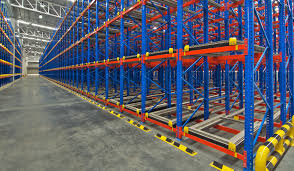Although they are two quite different worlds, building projects and warehouse operations often cross unexpectedly. You are in the right place if you have ever questioned how excavators and warehouse racking systems interact.
Air compressors are often used alongside excavators in warehouse construction or maintenance projects.
Let’s talk about these technologies and how they interact with one another.
Understanding Warehouse Racking
Fundamentally, warehouse racking systems are constructions meant to store goods effectively. Whether you deal with large pallets or more miniature goods, these methods maintain safe, orderly access to inventory.
From retail to manufacturing, they find application in many different sectors. The most often used racking systems are:
- Pallet Racks: Ideal for storing large, heavy loads on pallets.
- Cantilever Racks: For long or bulky items like pipes and lumber.
- Drive-In or Drive-Through Racks: Allow forklifts to load and unload goods directly.
- Selective Racks: Provide quick access to individual pallets.
Here, the main benefit is organisation. Without these systems, materials would accumulate randomly on the floor, making retrieval time-consuming and unsafe.
Why Are Excavators Important in an Industrial Context?
Designed for digging, lifting, and carrying big goods, excavators are. Although they are common on building sites, their applications go much beyond those of construction. They are flexible and indispensable for jobs including site development, trenching, and material handling.
The key parts of an excavator are:
- Boom: The arm reaching out for stuff.
- Bucket: Designed for surface scoops or digs.
- Cab: Where the operator controls the machine.
- Track or wheels: Provides mobility across uneven ground.
From small models for confined areas to enormous ones for projects, excavators range in size. Their quick material movement makes them essential in many different kinds of industry.
How Excavators and Racking Systems Work Together
At first look, racking systems and excavators seem unconnected. Iin some sectors, they create a potent mix. Two main phases define their cooperation: installation and daily running.
Setting Up Warehouse Racking Systems
The ground has to be ready while building a warehouse. That’s where excavators are helpful. These levelers of earth eliminate trash and get the location ready for installation. A poorly prepared foundation could lead systems of racking to tilt or fall.
Excavators help to guarantee that surfaces are level, sturdy, and ready for heavy-duty a warehouse racking system. Larger facilities can dig trenches for drainage systems or electrical conduits supporting the warehouse architecture.
Material Movement and Storage
Especially in sectors like lumber, building supplies, or scrap metal, excavators can also help to manage the goods kept on racking systems. An excavator might, for instance, raise large, bulk goods onto pallets, which forklifts then load into the racking system.
In more difficult terrain, where forklifts cannot readily negotiate outside conditions, excavators help to move goods near staging sites. This seamless handoff between excavators and warehousing tools maintains effective operations.
Industries Where They Work Hand-in-Hand
Some rely on excavators and racking systems to keep some businesses running.
Supply Warehouses
Smart storage solutions are needed for building products including beams, pipelines, or concrete blocks. While excavators move large goods across the site, Cantilever racking systems contain oddly shaped materials.
Facilities for Recycling
Excavators are quite important for sorting and loading goods in recycling facilities or scrapyards. Racking systems then enable simple processing by type-based item storage.
Retail Distribution Centers
Excavators could even be utilized for outdoor storage yards containing large quantities of merchandise, even for retail distribution. From there, items flow within orderly racking systems, ready for delivery.
Benefits of Using These Tools Together
The advantages are obvious when one understands how excavators and warehouse racking systems work in tandem:
- Improved Efficiency: You reduce delays by handling material movement and storage strategically.
- Enhanced Safety: Properly installed racking systems and steady handling from excavators minimise the risk of accidents.
- Cost Savings: Keeping operations organised saves money by reducing waste and optimising productivity.
In Conclusion
Although excavators and warehouse racking systems have diverse uses, combining them is more beneficial. While racking systems give the organisation companies need to flourish, excavators undertake the heavy lifting and groundwork. Even equipment needed at the earliest stage of your warehouse construction, such as a road roller, have an essential role to play.
An effective mix of these technologies will produce a safer, faster, more efficient workflow. Understanding this link could make all the difference, whether you manage a crowded warehouse or establish a new facility.






